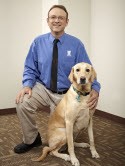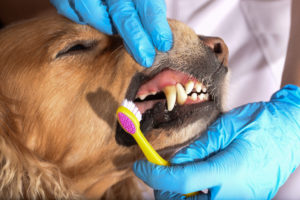Mrs. Smith is upset and worried. She brought Bowser, her nine year old lab, in to the vet because he has been acting slightly down. She also had noticed that his breath had become very bad, much worse than just the “doggy breath” she was used to over the past few years. The vet examined Bowser and drew blood tests. Everything turned out normal, except for one glaring problem. The vet showed Mrs. Smith what Bowser’s teeth looked like by lifting Bowser’s lip. Mrs. Smith was shocked when she saw the dark brown discoloration covering all the teeth, and the severe inflammation of the gum tissue. Now she was facing the fact that Bowser needed to have anesthesia to have the teeth cleaned, evaluated, radiographed, and some possibly extracted.
How can we help our pets avoid severe dental disease like Bowser’s? People don’t think of their pets’ teeth as needing preventive care. But their teeth are similar to humans (although different shapes and sizes), in that they need maintenance to keep them from succumbing to disease. And, just as in humans, even with good care they might have problems with some teeth, just not as serious or as extensive of problems. Here are some things people need to realize about pet dental care:
Seven Lesser Known Facts About Pet Dental Care
1) A majority of dogs and cats will continue to eat and act seemingly normal even with painful conditions in their mouths.
I am continually amazed at some of the problems I find in animals’ mouths, when there is no report of decreased appetite, severe inflammation, broken teeth, rotten roots, or tumors; these are just some of the things we find. Some symptoms (if any) pets might show include dropping food out of the mouth, taking longer to eat, swelling in or around the mouth, discharge from the mouth, small amount of gum bleeding while or after eating. But lack of trying to eat is a rare symptom.
2) “Doggy Breath” is not normal.
Our dogs’ and cats’ breath might not be immensely pleasant, but it should not be rancid. Obviously, if they just ate, it will smell like the food. Or if they just ate something only dogs would eat (dirt, animal feces, other delicacies), then bleh. But overall it should not smell foul. This indicates at the very least that bacteria is colonizing under the gum line. It could also indicate more serious problems in the mouth, such as abscessed roots. Rarely, bad breath can be an indication of a problem elsewhere in the body. In any case, an exam is warranted.
3) Professional anesthetized dental cleanings and radiographs should be done yearly.
Most people brush their own teeth at least daily and many floss daily. Still, we need professional cleanings yearly (sometimes more often) and problems can still be found. Imagine if you never brushed your teeth, how bad they would be. Now think of our pets, most never have their teeth brushed. While dogs and cats rarely get cavities like humans, they almost always get periodontitis, or inflammation and infection around the teeth and the roots. Yearly cleanings done under anesthesia removes the tartar that has accumulated under the gum line, and radiographs detect any early (or sometimes late) problems under the bone in the roots. Cleanings done without anesthesia and without radiographs are not considered standard of care and are a topic for another blog. Just don’t do it!
4) Home preventative care is important.
Plaque, a biofilm of thick fluid mixed with bacteria, adheres to the enamel of the teeth and forms a tight bond within 24 hours. This bond cannot be broken without a professional scaling. Brushing removes the plaque if it is done before the 24 hour window. This is why dentists tell us humans to brush at least daily, and unfortunately, is why our pets should have their teeth brushed daily. Once the plaque adheres to the enamel it attracts minerals from the saliva, which leads to tartar formation, then it turns into a thick mineral layer called calculus. This mineralization traps bacteria under it, allowing the only place the bacteria can go is under the gum line. The bacteria causes erosion of the bone around the roots and causes the tooth to loosen and can lead to an abscess. Brushing can be difficult, but one can always bring their pet in for a free demonstration and help with brushing.
5) There is no way I’m brushing my dog/cat’s teeth, what else can I do?
The second best home care for pets is daily dental treats. There are even diets designed to help the teeth. One diet, T/D by Hill’s, is large chunks of kibble, for both dogs and cats, which scrapes the teeth as they chew. Many people use a few pieces of the kibble as a daily treat and not as a whole diet. Chewing treats such as biscuits and thin rawhide chews also help. One study showed that beagles who ate one dental treat a day had less tartar than those that didn’t. There are a plethora of dental treats on the market for pets. One way to be sure that a product works well is to look for the seal of approval from the VOHC, or Veterinary Oral Health Council. This is a group of veterinary dental specialists who analyze products and evaluate their claims of controlling plaque and tartar. To see a list of VOHC approved products you can check out their web site at www.vohc.org
6) Disease in the mouth can affect the whole body.
Dental disease can cause bacteria to enter the bloodstream through the gum tissue and travel to other parts of the body, such as the kidney, liver, and heart valves. The inflammation in the mouth might also worsen body wide problems. Studies have shown that some disease, such as diabetes, have better control if dental and oral disease is taken care of.
7) Start early.
The best time to start thinking about oral health in a pet is when they are a puppy or kitten, or first adopted if they are already adults. Try to get them used to brushing early. Use a flavored animal tooth paste (never human tooth paste) and they might even like it, thinking they are getting a treat. Use a dental treat after brushing, then they might look forward to that. And, the first professional cleaning in medium to large breed dogs, and also cats, should be done no later than 3 years old, while in small breed dogs it should be done around one year old. We now offer a gingival sealant that helps reduce the chance of bacteria from getting under the gum line and lasts six months; we suggest applying this at the puppy or kitten’s spay or neuter, as it requires a professional application under anesthesia.
Mrs. Smith is happier now. Bowser had the dental cleaning and only had to have two teeth extracted. She saw the before and after pictures of the cleaning and the radiographs of the disease around the roots of the affected teeth. These pictures demonstrated the severity of the dental disease. Bowser now seems brighter and has more energy. She gives him a dental treat daily and will try to brush the teeth once the extraction sites are healed. She had the gingival sealant applied at the end of the dental procedure and will bring him in for reevaluation in six months. At home, she started brushing the teeth of Scooter, the 5 month old puppy she just adopted, to get him used to it. She also agreed to have the gingival sealant applied at Scooter’s neuter and will have professional anesthetized cleanings yearly starting when he turns three. Scooter and Bowser are lucky puppies!!!

Dr. Ray Phillip, Chief of Dentistry, has practiced at Friendship since 1992 after graduating from the University of Tennessee College of Veterinary Medicine. He has worn many hats at Friendship – including emergency veterinarian and surgeon – before joining Friendship Dental Services full time.
* Featured image courtesy of Burns Family Dentistry.

